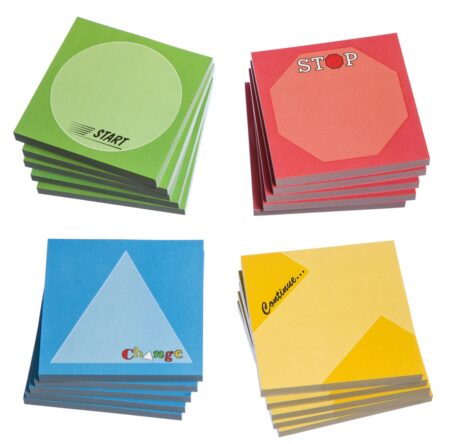1-2-4-All Training Technique
I had the pleasure of co-facilitating a session with veteran trainer, Nora Gerber, who was kind enough to share some of her tricks of the trade. Nora applies the 1-2-4-All training technique to a variety of “task cards.” This active learning approach is a whole-brain processing tool that builds engagement, encourages self-reflection, and enables big-group sharing. While Ms. Gerber affirms that these approaches work well for her, she encourages trainers to adapt them and make them their own. Following are Nora Gerber’s tips:

Start-Stop-Continue-Change Sticky Notes by Trainers WarehouseBUY NOW
TASK CARDS
TASK CARDS are learning tools that supply a prompt, question, quote, behavior, etc. in small, individual chunks that learners can manipulate as they reflect, process, and share course content-related topics. The Task Card itself is not the training; rather, it is a tool to use when delivering course content & facilitating growth.
WHEN USE THEM?
Use task cards, and the 1-2-4-All approach described below, throughout the learning day and in a variety of formats. Its beauty is that it’s so adaptable, no matter what topic you teach, the age of your learners, or where you are. For instance, use them:
- Seated or moving about the room
- During virtual & live events
- As openers, reinforcers, energizers, or closers
- With physical card decks and sticky notes or online images and PDFs
- In small or large gatherings of adults & youth learners
WHY USE THEM?
We use this approach because it works. And, it works because it’s consistent with Bowman’s 6 Brain Science Principles of Learning.
- Course content-related conversation jump-starters, in small chunks
- Upbeat & pleasurable (fun) colorful experiences
- Individual bits of data in a manipulatable form
- Customization options for my audience/ content/ time/ planned outcomes
- Flexible levels of engagement: short-quick-simple >> longer-higher
1 – 2 – 4 – All APPROACH
“1” – INDIVIDUAL REFLECTION
Thinking to myself about what I’m thinking. Taking time for reflection, retrieval, and preparation.
BENEFITS: Inviting independent reflection ensures the engagement of every individual.
- Silent Reflection – on your own, think about your answers to one or several prompts.
- Journaling or action planning — develop a written response to the prompt(s).
- Bit-by-bit, review or reinforcement – allocate brief periods of time throughout the course to capture concepts/ quotes/questions, or organize notes.
“2” – TWO-BY-TWO / PAIR & SHARE/ THOUGHT PARTNERS
Processing learning with ONE peer (seated, standing, or walking), requiring participants to vocalize their thoughts and share feedback.
BENEFITS: Partnering lowers the risk of participation. It also helps clarify thinking, reinforces concepts, provides peer support, encourages voice and choice, and provides practice for discussing ideas in larger groups.
- Turn ‘n Talk – Turn to ONE person seated nearby and share responses to prompts.
- Stand & Partner up – Stand up, take your task card with you, and join ONE person who is not at your table or seated near you and share responses, then be seated.
- 2-by-2 Move about – Stand, move about the room, stop, and swap responses with ONE person at a time, 4-5 times; each could be for a designated amount of time (or not) still explicitly orchestrating it for one-to-one conversations for a given amount of time (music could indicate start/stop).
- Swap-a-roo – Same as the 2×2 above, but after chatting with your partner, swap prompt cards before you move on to find your next partner.
- Casual Cruise and Schmooze — find a partner then go on a walk together and swap thoughts with another pair about the prompts on your cards.
- Choreographed Cruise and Schmooze – pair up then have all pairs circumnavigate the space clockwise, in step to music and to each other, leaving space between you and other pairs; share responses; link elbows if appropriate and preferred
- Speed Dating – have participants form two face-to-face concentric circles (inner & outer), with the same number of people in each circle. Have partners share with the person directly opposite them for a set number of minutes (i.e. 2 minutes). When time is up, at the facilitator’s direction, have them shift to the next partner in the circle and swap responses (tell the inner circle to move clockwise and the outer circle to move counterclockwise). Suggest they get concise & talk fast then move along, ready or not
“4” – SMALL GROUP GATHERINGS (a.k.a. Task Teams/ Table Talk/ Huddles)
Small group work (seated or standing) promotes idea-sharing with peers and the trainer.
BENEFITS: By expanding groups, participants can explore a more diverse array of ideas and knowledge, collaborate on a team response or task completion, and summarize perspectives in preparation for sharing with “ALL.”
- Table Team Talk – swap responses to the cue card prompts with others at your table; whoever has something relevant to say starts talking; others join in, add value, keep the conversation going for the designated amount of time (flex it); no report out or product expected.
- Team Huddle – move to a designated space in the room to converse with others focused on a theme/ concept/ content category; groups can be organized by numbering off, or by a focus sign posted on the wall for a standing huddle or seated at a table designated as a specific focus group.
“ALL” – REGROUP FOR A WHOLE-GROUP EXCHANGE
Facilitate open discussion, exercise debriefs, group reports, individual perspectives, Q&A, etc.
BENEFITS: The participant group gains the value of hearing other groups’ summaries, reports, and broader perspectives. The trainer can add value by responding to the whole group’s remarks and questions.
- Q & A – Remember, the goal is to reinforce content, help participants make connections, and draw conclusions. To elicit questions and bypass the crickets, replace “Any questions?” OR “There’s no such thing as a dumb question” with one of these:
- “I’m curious. I’m wondering what you’re wondering about…”
- “Turn to someone nearby or to your table team and ask a question – they might provide you with answers. If they don’t know either, ask me your questions as a pair or group.”
- For an experiential debrief, you might ask, “What Happened?” “So What?” or “Now What?”
- Pose the question for solo reflection before eliciting group responses.
- Always ask for volunteers. NEVER put someone on the spot without an indication that they are ready to respond. #amygdalatrigger&hijack
- TEACH BACK – Ask small groups to put their responses into their own words/images/rap and deliver their “lessons” to others, with the goal of reinforcing content, inspiring others, raising awareness, entertaining, and engaging others in the learning process. #traineesarelearningwhattheyaredoing
NOTE: This is adapted from Henri Lipmanowicz and Keith McCandless, The Surprising Power of Liberating Structures
TASK CARDS + THE 1-2-4-All APPROACH
When putting it all together, Nora explains, “I always start with #1 (individual work) to engage all brains. I might add # 2 and stop there or add #4 for more engagement. However, I always end with “All” to regroup and move on. That said, feel free to mix it up, both to add variety and fit your circumstances (objectives/content/time/ # of participants / audience’s culture and learning style preferences).”
Image from Nadia von Holzen

